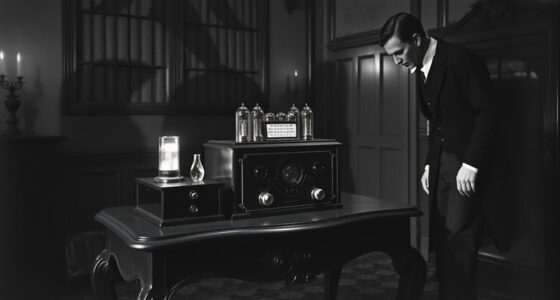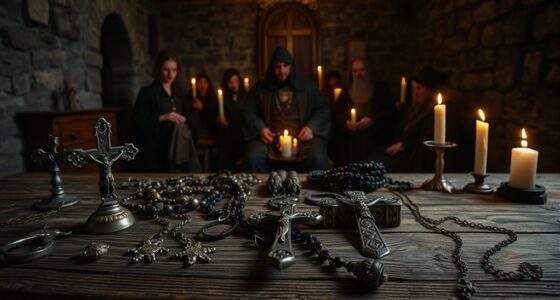In 1804, tensions and superstitions in Hammersmith led to a tragic mistake when a man was wrongly shot during a community panic over a supposed ghost. Fear and miscommunication fueled chaos, causing someone to fire in self-defense. The incident sparked a trial influenced by social biases and superstitions. To understand how superstition and hysteria caused this deadly misunderstanding—and how it changed justice practices—keep exploring this remarkable case.
Key Takeaways
- The case involved a mistaken identity of a ghost, leading to a shooting in Hammersmith in 1804.
- Community fears, superstitions, and rumors fueled tensions and misunderstandings before the incident.
- A man was wrongfully shot during panic, highlighting the dangers of superstition-driven violence.
- The trial reflected societal fears, with verdicts influenced by social biases and limited evidence.
- The case prompted legal reforms to improve police procedures and reduce superstition-based violence.
The Events Leading Up to the Tragedy
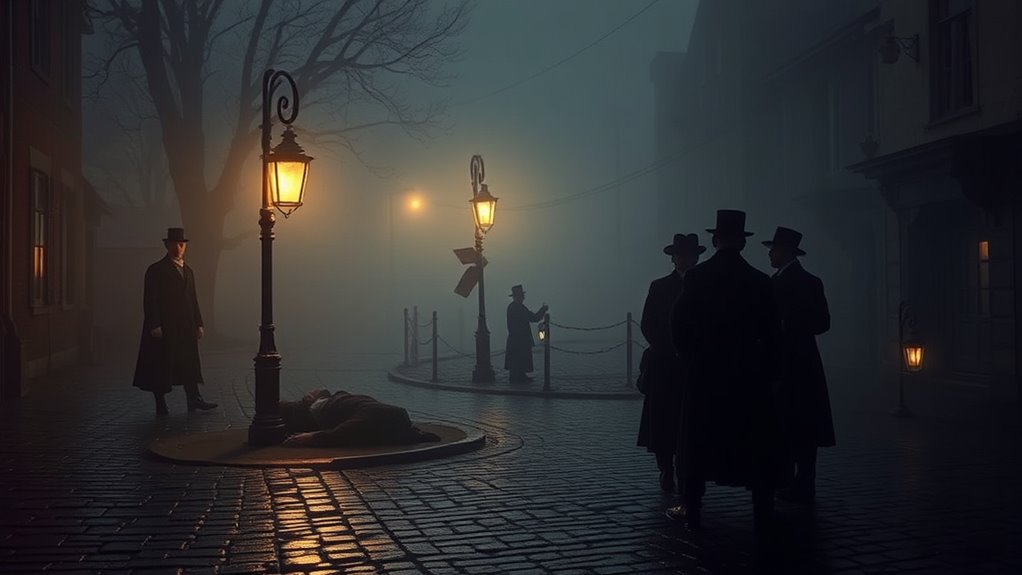
On the night of January 29, 1804, tensions in the Hammersmith area had been rising due to recent disturbances and rumors of thefts. Superstitious beliefs heavily influenced how locals perceived these events, fueling fear and suspicion. Community tensions grew as some residents blamed supernatural causes or local mischief for the unrest. Rumors spread that strange sightings and unexplained noises were signs of malevolent spirits or curses. These superstitions led people to be more alert and easily alarmed. The refrigeration cycle, which involves the absorption and release of heat, was not understood at the time, but the atmosphere was similarly affected by false perceptions and misunderstandings. As night fell, the atmosphere became charged with anxiety, with neighbors wary of outsiders or even each other. The combination of heightened suspicions and superstitions created an environment ripe for misunderstanding, setting the stage for the tragic events to follow. Additionally, the pervasive influence of superstitions intensified people’s reactions and contributed to the tragic outcomes. A misinterpretation of events further fueled the panic, which was compounded by lack of accurate information, making the situation more volatile. Moreover, the lack of accurate information and effective communication among residents exacerbated the situation, making it more difficult to resolve misunderstandings peacefully.
The Night of the Shooting
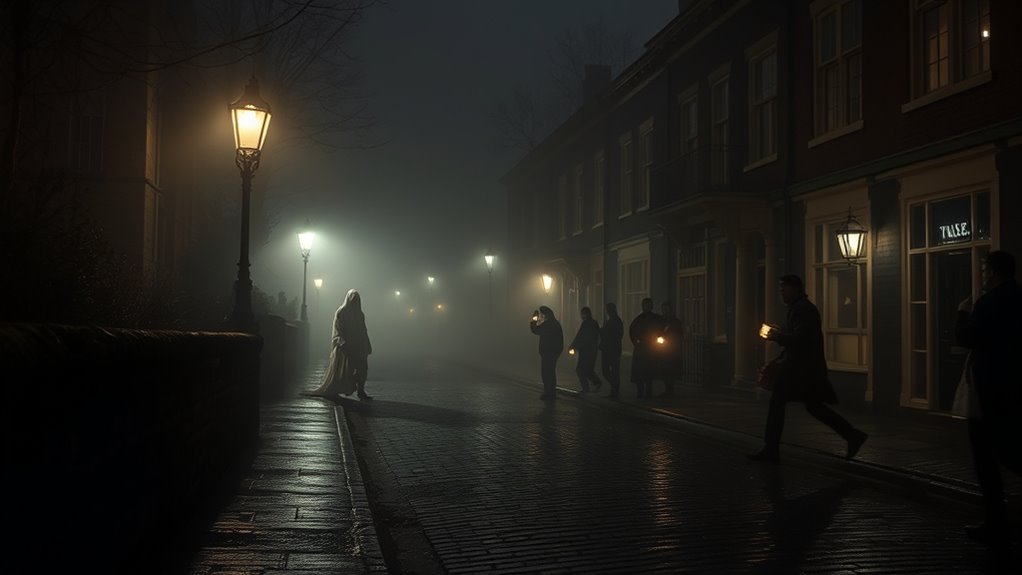
On the night of the shooting, you can imagine the tense moment when the encounter between the victim and the attacker took a tragic turn. The incident unfolded quickly, leaving no time for hesitation or doubt. This shocking event forever changed the lives of everyone involved. In the aftermath, questions about the proper support systems and community responses emerged, highlighting the importance of effective communication and emotional resilience. The tragic nature of the case also prompted discussions about public safety measures and community vigilance during such crises. Additionally, understanding the role of community response can help prevent future tragedies and foster a safer environment for all residents. Recognizing the importance of attention and focused awareness during critical moments can also contribute to better community safety strategies, especially when considering the role of mental health support and intervention.
The Fateful Encounter
That night, as darkness cloaked the Hammersmith neighborhood, a tense atmosphere hung in the air. You might have felt the uneasy tension, fueled by ghostly encounters and superstitious beliefs that haunted locals. Around you, shadows stretched long, and every rustle seemed amplified by fear. The encounter that changed everything unfolded swiftly, with a figure mistaken for the ghost lurking near the churchyard. Your senses heightened as you approached, eyes wary of spectral shapes. The villagers’ superstitions contributed to the chaos, intensifying the sense of danger. What was meant to be a routine patrol turned into a fateful moment, driven by fear and superstition. The night’s events would forever alter perceptions of the supernatural and reality in Hammersmith. Additionally, the use of data analytics in understanding local fears and behaviors could have provided insights into managing such incidents more effectively, especially considering the cybersecurity vulnerabilities that often accompany chaos and misinformation. Recognizing the importance of community engagement might have also helped in calming tensions and preventing such tragic outcomes. Implementing remote communication tools could have facilitated better coordination among villagers and authorities during the crisis. Furthermore, understanding the psychology of fear could have helped authorities address the community’s anxieties more constructively.
The Shooting Incident
How did a moment of panic escalate into a deadly shooting? It all began with a ghostly misidentification fueled by community paranoia. Someone saw a figure in the dark, mistaking it for the notorious Hammersmith ghost, and panic took over. Without hesitation, the shooter fired, believing they were defending themselves against a threatening spirit. The chaos spread quickly, with others joining in, convinced they faced supernatural danger. The shooting was sudden and tragic, turning a simple scare into a fatal incident. The community’s fear and suspicion, amplified by ghostly misidentification, led to this tragic loss of life. That night revealed how collective paranoia can escalate ordinary fear into deadly violence. Additionally, the incident underscored the importance of understanding bicycle safety and the potential consequences of uncontrolled reactions.
The Investigation and Arrests

As investigators explored the Hammersmith Ghost murder case, they quickly identified potential suspects through witness testimonies and physical evidence. You follow strict police procedures, gathering statements from locals who saw the figure and noting inconsistencies. The witnesses’ accounts pointed toward a young man, which led to his swift arrest. Key steps included securing the crime scene, collecting physical clues, and interviewing other residents. Your team prioritized corroborating witness accounts with physical evidence to build a solid case. The suspect’s arrest was based on these combined elements, ensuring due process. Through meticulous investigation, you narrowed down suspects, demonstrating thorough adherence to police procedures. This methodical approach ultimately set the foundation for the subsequent legal proceedings.
Social Context and Superstitions of the Time
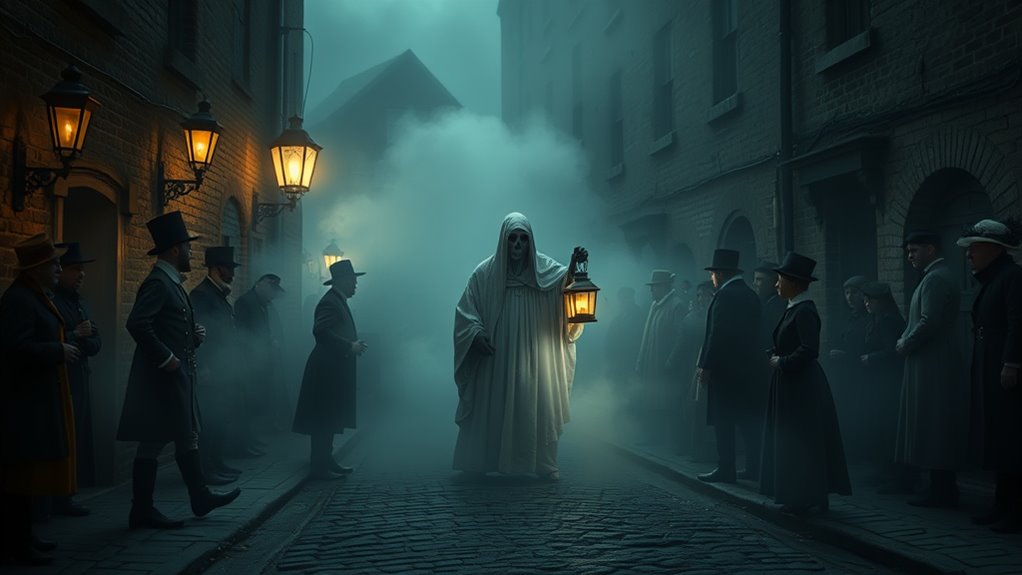
During the period surrounding the Hammersmith Ghost murder case, superstitions and social beliefs heavily influenced local communities. Superstition influence was strong, shaping how people perceived danger and morality. Many believed in supernatural forces, ghosts, and spirits, which heightened fear and suspicion. Social hierarchy played a role too; lower classes often relied on superstitions to explain misfortunes, while the upper classes viewed them as primitive beliefs. These superstitions reinforced social divisions, with authority figures sometimes dismissing popular fears or using them to control the populace. You can see how deeply rooted these beliefs were, affecting daily life and decision-making. The case exemplifies how superstition influence intertwined with social hierarchy, creating a climate where fears could easily escalate into violence.
The Trial and Its Aftermath
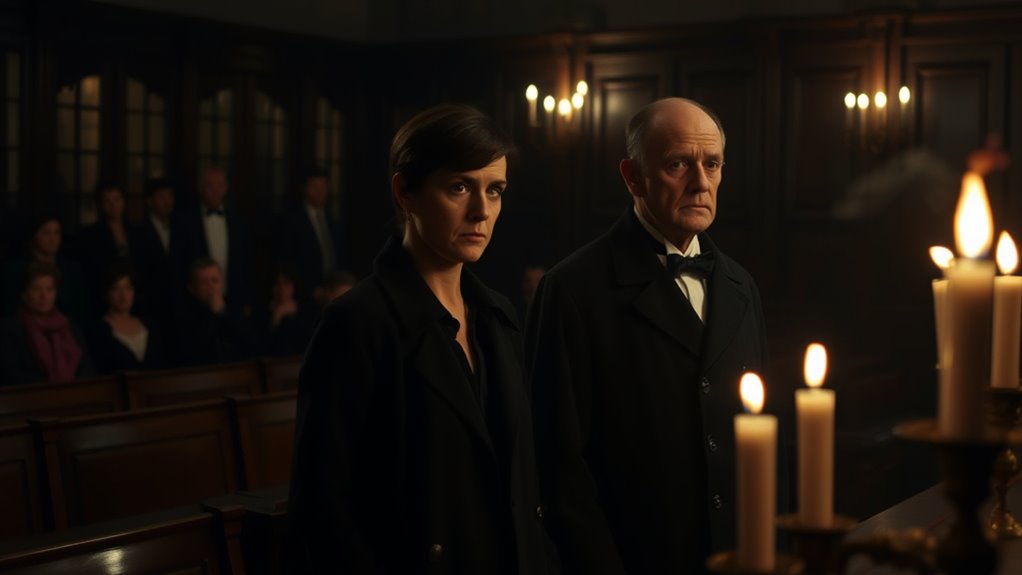
The trial of the accused in the Hammersmith Ghost murder case drew intense public attention, reflecting the deep-seated fears and social tensions of the time. You observe that the trial procedures were straightforward but charged, with the jury tasked with determining guilt based on limited forensic evidence. During jury deliberations, tensions ran high as societal fears influenced their decision-making. Key aspects included:
- Presentation of witness testimonies regarding the shooting
- The defendant’s defense strategy emphasizing mistaken identity
- Judicial instructions on evaluating intent and evidence
- The jury’s careful weighing of social biases and superstitions
Ultimately, the verdict carried significant weight, shaping public perceptions of justice and highlighting the era’s societal anxieties.
Legacy and Lessons From the Case
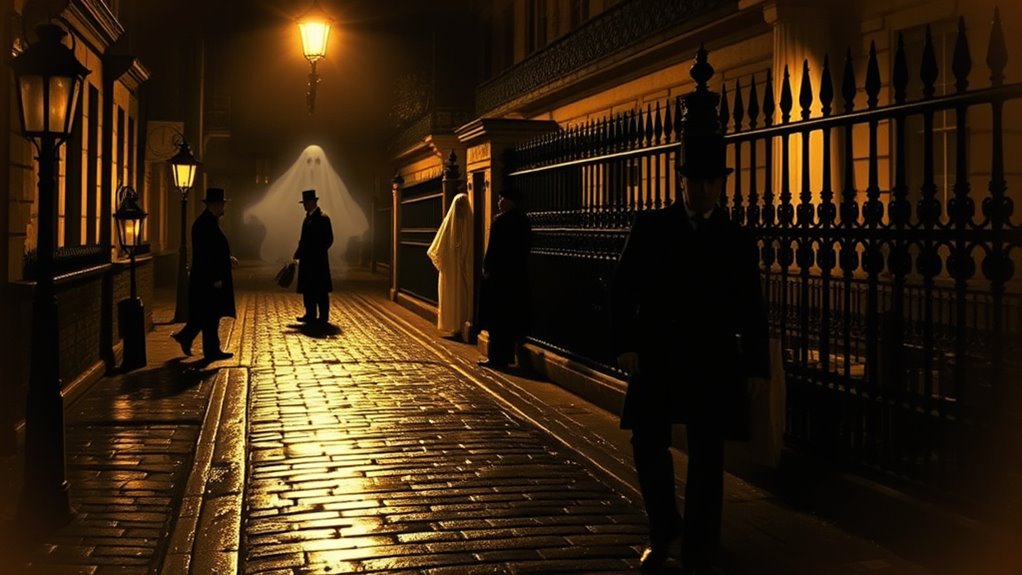
This case led to important legal reforms aimed at preventing similar tragedies. It also prompts you to reflect on ethical responsibilities during tense situations. Ultimately, it reminds us how justice systems can be shaped and improved by such tragic lessons.
Legal Reforms Inspired
The Hammersmith Ghost murder case prompted significant legal reforms that aimed to prevent similar tragedies in the future. It exposed how ghost stories and superstitious beliefs could lead to deadly misunderstandings and reckless actions. As a result, laws were introduced to improve community communication and police accountability. These reforms sought to reduce the influence of superstitions in criminal investigations and public safety. You’ll find that authorities now emphasized evidence-based policing over superstition-driven assumptions. The case also prompted clearer guidelines on the use of force and the importance of verifying identities before taking action. These changes aimed to prevent wrongful accusations and protect innocent lives from hysteria fueled by ghost stories and superstitions. Ultimately, the case became a catalyst for more rational, structured legal procedures.
Ethical Reflection Lessons
Legal reforms following the Hammersmith Ghost murder highlight the importance of ethical decision-making in law enforcement. This case reminds you that moral responsibility extends beyond individuals to societal accountability. When acting under pressure, it’s crucial to prioritize ethics over haste or prejudice. Reflecting on this tragedy, consider how accountability shapes justice and trust. The table below illustrates lessons learned:
| Ethical Principle | Application in Law Enforcement |
|---|---|
| Moral Responsibility | Ensuring officers understand the impact of their actions. |
| Societal Accountability | Holding authorities accountable to maintain public trust. |
| Ethical Decision-Making | Making choices that align with justice and morality, especially under stress. |
Impact on Justice
The Hammersmith Ghost murder case left a profound mark on the justice system, illustrating how swift actions driven by fear can lead to tragic outcomes that undermine public trust. It highlighted the need for careful courtroom procedures to guarantee justice is accurately served, rather than based on haste or assumptions. This case set a legal precedent emphasizing the importance of thorough evidence evaluation before conviction. It also prompted reforms in police protocols and the standards for self-defense claims. By examining this case, you understand that justice must balance promptness with fairness to prevent wrongful punishments. The lessons learned continue to influence modern legal practices, reinforcing the necessity of meticulous procedures in safeguarding individual rights. Ultimately, it underscores that justice relies on deliberate, evidence-based processes.
Frequently Asked Questions
How Did the Community React Immediately After the Murder?
After the murder, you would see the community mourning the loss, with residents visibly shaken and grieving deeply. Public hysteria quickly spreads as rumors and fear take hold, leading to heightened suspicion and chaos. People become more suspicious of strangers and quick to judge, fearing another violent act. The community’s immediate reaction reflects shock and unrest, as they struggle to process the tragedy and seek comfort amid the turmoil.
Were There Any Similar Incidents of Ghost-Related Violence Before 1804?
You might find that incidents of superstitious violence linked to ghost legends were rare before 1804. While ghost-related stories existed, actual violence inspired by these tales was uncommon. Communities generally dismissed such legends as mere folklore. However, when fears grew, some towns saw minor conflicts rooted in superstitions. Overall, before the Hammersmith case, ghost-related violence was mostly myth, not a significant problem, making the 1804 incident quite unusual.
What Influence Did Local Superstitions Have on the Case’s Outcome?
Imagine superstitious beliefs fueling community paranoia, turning a simple mistake into a tragic event. In this case, local superstitions intensified fears of ghosts, making villagers quick to shoot at shadows. Their beliefs led to misjudgments and violence, ultimately influencing the case’s outcome. Ironically, what was thought to be a supernatural threat was just a man mistaken for a ghost, showing how superstition can distort reality and escalate panic.
Did the Case Lead to Changes in Law Enforcement Procedures?
You’ll find that the case prompted significant police reforms, leading to improved law enforcement procedures. It exposed flaws in how authorities handled the situation, prompting legal reforms to prevent similar mistakes. As a result, police became more cautious and systematic in their investigations. This case’s aftermath pushed for better training and clearer protocols, ensuring that future incidents would be managed more effectively, ultimately strengthening the justice system.
How Is the Hammersmith Ghost Murder Remembered Today?
Think of the Hammersmith Ghost murder as a ghostly whisper from history, reminding us of lessons learned. Today, it’s remembered through modern memorials and ongoing historical reinterpretations that honor the tragedy. You can see its legacy in how communities reflect on justice and safety, ensuring that such a haunting chapter isn’t forgotten. Its story lives on, echoing in the ways we remember and learn from the past.
Conclusion
You might believe the Hammersmith Ghost murder was just a tragic accident, but some suggest it was fueled by superstitions and mistaken identity. Perhaps, in the chaos, a false belief in supernatural danger led to violence. This case reminds you how fear and ignorance can escalate into tragedy. By questioning such theories, you see how societal beliefs shape actions—making it clear that understanding history helps prevent similar mistakes today.


